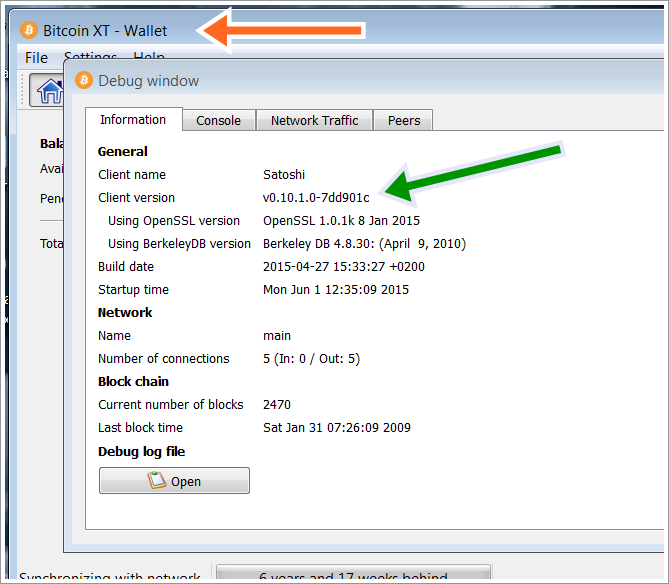Bitcoin XT: Difference between revisions
Whatever the source says, that paragraph is nonsense |
Wladimir really has nothing to do with this |
||
| Line 5: | Line 5: | ||
}}'''Bitcoin XT''' is a fork of [[Bitcoin Core]] that aims to make transactions reliable, inexpensive, and accessible. It achieved significant notoriety and support after prematurely adopting [[BIP 0101|BIP 101]], making it an important proponent of the [[block size limit controversy]].<ref name="ooc">{{cite web|work=[[The Neighbourhood Pool Watch]]|author=[[organofcorti]]|title=BIP101 implementation flaws|date=27 August 2015|accessdate=27 August 2015|url=http://organofcorti.blogspot.com/2015/08/bip101-implementation-flaws.html}}</ref> | }}'''Bitcoin XT''' is a fork of [[Bitcoin Core]] that aims to make transactions reliable, inexpensive, and accessible. It achieved significant notoriety and support after prematurely adopting [[BIP 0101|BIP 101]], making it an important proponent of the [[block size limit controversy]].<ref name="ooc">{{cite web|work=[[The Neighbourhood Pool Watch]]|author=[[organofcorti]]|title=BIP101 implementation flaws|date=27 August 2015|accessdate=27 August 2015|url=http://organofcorti.blogspot.com/2015/08/bip101-implementation-flaws.html}}</ref> | ||
After | After [[Gavin Andresen]]'s resignation from the position of [[Core maintainer]], he and [[Mike Hearn]] organized{{when}} Bitcoin XT to address controversial ideas lacking the consensus required to be implemented in Bitcoin Core.<ref>{{cite web|work=Medium|title=An XT FAQ|author=[[Mike Hearn|Hearn, Mike]]|date=27 August 2015|accessdate=27 August 2015|url=https://medium.com/@octskyward/an-xt-faq-38e78aa32ff0}}</ref> | ||
Due to implementing BIP 0101 in version 0.11.0A, it is now incompatible with the Bitcoin consensus protocol, and when 75% of the last 1000 blocks are observed to have particular version bits set, it ceases enforcing the 1 MB block size limit and also adds a few new rules. | Due to implementing BIP 0101 in version 0.11.0A, it is now incompatible with the Bitcoin consensus protocol, and when 75% of the last 1000 blocks are observed to have particular version bits set, it ceases enforcing the 1 MB block size limit and also adds a few new rules. | ||
Revision as of 23:14, 31 August 2015
Bitcoin XT is a fork of Bitcoin Core that aims to make transactions reliable, inexpensive, and accessible. It achieved significant notoriety and support after prematurely adopting BIP 101, making it an important proponent of the block size limit controversy.[1]
After Gavin Andresen's resignation from the position of Core maintainer, he and Mike Hearn organized[when?] Bitcoin XT to address controversial ideas lacking the consensus required to be implemented in Bitcoin Core.[2]
Due to implementing BIP 0101 in version 0.11.0A, it is now incompatible with the Bitcoin consensus protocol, and when 75% of the last 1000 blocks are observed to have particular version bits set, it ceases enforcing the 1 MB block size limit and also adds a few new rules. Since it is incompatible with the Bitcoin protocol, it is technically an altcoin, but due to an unusually large economic acceptance it may potentially become a "new Bitcoin" some day.
Mission statement
The XT mission statement defines what the project believes is important: commitment to these principles are what differentiates it from Bitcoin Core.
- Scaling the network up to handle user demand and spam is important, even if that means the network becomes centralised along the way. The idea of a global system used by ordinary people is what motivated many people to support this.
- XT proponents believe unconfirmed transactions are important. Many merchants want or need to accept payments within seconds rather than minutes or hours. XT accepts this fact and does what it can to minimise the risk, then "helps" sellers judge what remains. It is committed to support only "first seen" policies, and will not adopt changes that make unconfirmed transactions riskier.
- Decision making is quick and clear. Decisions are made according to a leadership hierarchy. The XT software encodes decisions that follow the above principles: people who disagree are welcome to use different software, or patch ours. We do not consider writing principled software to be centralising and do not refuse to select reasonable defaults.
You can read more about the code changes in Bitcoin XT.
Block size hard fork
In 2010, a block size limit was introduced into Bitcoin by Satoshi Nakamoto. He added it as a safety measure to prevent miners from spamming large blocks and meant for it to be removed once secure lightweight wallets were developed; however, the spam problem has only gotten worse, and secure lightweight wallets never implemented.
There has been much community debate on this topic. You can read analysis and explanations for why we think raising the block size limit is important here:
- A series of essays by Gavin Andresen
- Why the block size limit must be raised and why the proposed alternative schemes will not work, by Mike Hearn.
Miners
Miners that side with Bitcoin XT will produce blocks with a new version number.[3] This indicates to the rest of the network that they support XT.[3] When 75% of the last 1000 blocks are new-version blocks, these miners will automatically abandon Bitcoin and begin mining on a new Bitcoin XT blockchain.[3] This will begin after a waiting period of two weeks in hopes the economy in this time may force anyone who hasn't switched yet to do so.[3]
Users and miners running full Bitcoin nodes will reject the XT blockchain starting with the first block that is larger than one megabyte in size, and thus be unaffected provided it fails to achieve economic consensus.
Users and merchants
If insufficient mining hash power runs XT to reach supermajority then nothing will happen. If enough does, XT users will follow a new blockchain and cease to be using and trading bitcoins.
See Also
References
- ↑ organofcorti (27 August 2015). "BIP101 implementation flaws". The Neighbourhood Pool Watch. http://organofcorti.blogspot.com/2015/08/bip101-implementation-flaws.html. Retrieved 27 August 2015.
- ↑ Hearn, Mike (27 August 2015). "An XT FAQ". Medium. https://medium.com/@octskyward/an-xt-faq-38e78aa32ff0. Retrieved 27 August 2015.
- ↑ 3.0 3.1 3.2 3.3 Wilson, Fred (17 August 2015). "The Bitcoin XT Fork". AVC. http://avc.com/2015/08/the-bitcoin-xt-fork/. Retrieved 28 August 2015.

